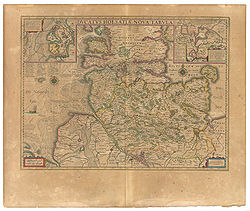- Holstein-Glückstadt
-
Duchy of Holstein
Herzogtum HolsteinState of the Holy Roman Empire
Member of the German Confederation← 
1474–1866  →
→Coat of arms
Ducatus Holsatiæ, ed. by Willem and Joan Blaeu, 1645 Capital Glückstadt (government), Itzehoe (parliament) Government Principality Historical era Middle Ages
Early modern Europe- Christian I of Denmark
Count of Holstein1460 - Duchy established 1474 - Joined
Lower Saxon Circle1500 - Split off
Holstein-Haderslev
and Holstein-Gottorp1544 - Duchy reunited 1773 - Member of
German Confederation1815 - Annexed by Prussia 1866 The Duchy of Holstein in Glückstadt was the northernmost state of the Holy Roman Empire. It consisted of the part of Holstein that was ruled by the king of Denmark; its capital was Glückstadt (founded in 1617) on the River Elbe.
History
Adolf VIII, the last Count of Holstein-Rendsburg and Duke of Schleswig had died without heirs in 1459. As Schleswig had been a fief of the Danish Crown it had to fall back to King Christian I of Denmark, who, himself a nephew of Adolf, also sought to enter into possession of Holstein. He was backed by the local nobility, who supported the continued common administration of both lands and by the 1460 Treaty of Ribe proclaimed him as the new Count of Holstein. Nevertheless the county south of the Eider River remained a subfief of Saxe-Lauenburg, itself a fief of the Holy Roman Empire. In 1474 Emperor Frederick III elevated Christian to Duke of Holstein, thus gaining imperial immediacy.
In 1544 Christian's grandson Christian III of Denmark divided the Duchies of Schleswig and Holstein into a royal Danish part and two subdivisions held by his younger half-brothers, who had to renounce the Danish throne:
- The Duchy of Schleswig-Holstein in Haderslev, held by Duke Hans the Elder. Hans had no issue and after his death in 1580 his territories were divided among his brothers.
- The Duchy of Schleswig-Holstein in Gottorp, held by Duke Adolf and his successors. In 1713 their estates in Schleswig including Schloss Gottorf were conquered by royal Danish troops in the course of the Great Northern War and in the 1720 Treaty of Frederiksborg, Duke Charles Frederick of Schleswig-Holstein-Gottorp had to cede them to the Danish crown. His remaining territories formed the Duchy of Holstein-Gottorp administered from Kiel. In 1773 Charles Frederick's grandson, Paul, Emperor of Russia finally gave his Holstein parts to Denmark in exchange for the County of Oldenburg and Holstein was reunited as a single state.
In 1640 the County of Holstein-Pinneberg, whose ruling house was extinct, was merged in the Duchy of Holstein, royal part. From 1648 the royal Danish parts of Schleswig and Holstein under Frederick III of Denmark were administered out of Glückstadt, known as the Duchy of Schleswig-Holstein-Glückstadt. Before 1773 its Holstein territory consisted of the following Ämter: Rendsburg, South Dithmarschen, Steinburg, Segeberg, and Plön. In addition, significant parts of Holstein were jointly administered by Holstein-Glückstadt and the Dukes of Holstein-Gottorp, mainly on the Baltic Sea coast.
After the 1815 Congress of Vienna the Holstein duchy of the Danish crown became a member of the German Confederation, resulting in several diplomatic and military conflicts about the so-called Schleswig-Holstein Question. Denmark managed to defend its rule over Holstein in the First Schleswig War of 1848-51 against the Kingdom of Prussia, however when in the course of the 1864 Second Schleswig War Prussian and Austrian troops crossed the Eider and conquered Schleswig, Christian IX of Denmark had to renounce both Schleswig and Holstein in the 1864 Treaty of Vienna. Holstein was put under Austrian administration until in the aftermath of the Austro-Prussian War it was finally annexed by Prussia in 1866.
See also
 Lower Saxon Circle (1500–1806) of the Holy Roman Empire
Lower Saxon Circle (1500–1806) of the Holy Roman EmpireEcclesiastical 
Secular Bremen (from 1648) · Brunswick (Blankenburg (until 1731) · Calenberg2 · Grubenhagen (until 1596) · Wolfenbüttel) · Hanover (from 1708) · Holstein (Glückstadt · Gottorp) · Lüneburg2 · Mecklenburg (Güstrow (until 1695) · Schwerin · Strelitz (from 1701)) · Rantzau (until 1734) · Regenstein · Saxe-Lauenburg2Cities 1 until 1648. 2 until 1705. Categories:- Former principalities
- Former countries in Europe
- States of the Holy Roman Empire
- States and territories established in 1474
- States and territories disestablished in 1866
- 1866 disestablishments
- Lower Saxon Circle
- History of Schleswig-Holstein
- Holstein
Wikimedia Foundation. 2010.


